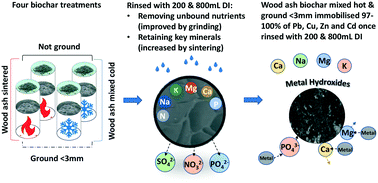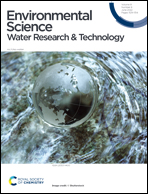Treatments of wood ash amended biochar to reduce nutrient leaching and immobilise lead, copper, zinc and cadmium in aqueous solution: column experiments†
Abstract
The pollution of aqueous environments by metals has continued to increase due to anthropogenic activities such as mining, waste disposal, industrial activities and the use of motor vehicles. Globally, vehicle numbers are predicted to increase to 2.8 billion by 2050 with aqueous pollutants associated with vehicles, such as Pb, Cu, Zn and Cd, increasing alongside vehicle numbers. With these increases, methods to minimise metal pollution are important to find; one such method is wood ash amended biochar. Whilst biochar has the potential to reduce contaminated runoff, this study explores the potential for the biochar itself to leach nutrients (PO43−, SO42− and NO3−) which are constituent parts of its biomass and potentially harmful to the ecosystem the biochar would be deployed to remediate. Treatments such as sintering wood ash to the biochar, granulating the biochar and rinsing the biochar were studied to ascertain their impact on the retention of minerals key to immobilisation, the leaching of nutrients and the immobilisation of Pb, Cu, Zn and Cd. It was demonstrated that wood ash sintered larch biochar granulated <3 mm (WASGr) retained the highest concentration of minerals associated with immobilisation, reduced leaching of nutrients to below Water Framework Directive thresholds and maintained Pb, Cu, Zn and Cd immobilisation at 97–100% once rinsed with deionised water. As a result, WASGr rinsed with deionised water, has the potential to be scaled-up and deployed to immobilise Pb, Cu, Zn and Cd from motorway runoff without a negative impact on the concentration of nutrients in the surrounding waters.

- This article is part of the themed collection: Recent Open Access Articles


 Please wait while we load your content...
Please wait while we load your content...